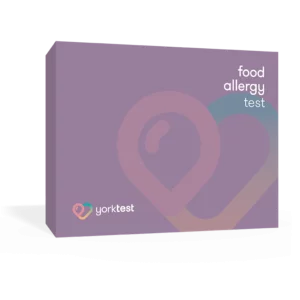- What is a Salmon Allergy?
- Is Salmon the Most Common Fish Allergy?
- Who is Most at Risk of Developing a Salmon Allergy?
- What are the Signs and Symptoms of Salmon Allergy?
- Salmon Allergy vs. Salmon Sensitivity
- The Importance of Salmon Allergy Testing
- What Foods to Avoid if You’re Allergic to Salmon?
- Other Types of Fish
- Crustaceans
- Fish Oil Supplements
- Sushi Rolls Containing Fish
- Salad Dressings
- Canned Soups and Sauces
- Fish-Based Pet Food
- How to Treat & Prevent a Salmon Allergy
- Salmon Allergy and Sensitivity Testing with YorkTest
A fish allergy is one of the more prevalent food allergies, reported to affect approximately 0.4% of the U.S. population. Individuals with a salmon allergy may also experience cross-reactivity with other types of fish or seafood.
The United States is in the top three largest consumers of salmon worldwide, alongside Japan and the European Union. Well-known as a good source of omega-3 fatty acids, proteins, and vitamins, the popularity of salmon is understandable. However, for those who suspect they are allergic to salmon, the fish could have considerable health risks rather than benefits. Here we delve into the symptoms of a salmon allergy, highlight other cross-reactive foods you should be mindful of consuming and ways to test, manage, and prevent a salmon allergy from disrupting your life.
What is a Salmon Allergy?
A salmon allergy is when your immune system overreacts to specific proteins found in salmon, causing various allergic reaction symptoms.
More specifically, the allergic reaction is caused by Immunoglobulin E (IgE) antibodies, which are part of our body’s defense mechanisms. These antibodies mistakenly see the proteins in salmon (namely, “Sal s 1”) as invasive, foreign intruders. It is these IgE-mediated antibodies that can lead to swelling, rashes, and other unpleasant symptoms characterized by the allergy.
Is Salmon the Most Common Fish Allergy?
Salmon, tuna, and cod are considered to be the most common fish allergens. A study in Texas found that 23.8% of fish allergy patients reported a salmon allergy.
Who is Most at Risk of Developing a Salmon Allergy?
Anyone can develop fish allergies at any age, but those with a family history of seafood or fish allergies are more susceptible. Individuals with existing food allergies – particularly to other forms of seafood – are also significantly more likely to develop an allergy to salmon.
For example, about 50% of patients who are hypersensitive to cod fish are reported to have similar allergic reactions to salmon. Similarly, someone allergic to tuna may also experience symptoms when consuming salmon. This is largely due to fish parvalbumin, a common allergen that’s responsible for cross-reactivity among different fish species.
Unlike most other major food allergies that typically begin during childhood, fish allergy often develops later in life. A study published by The Journal of Allergy and Clinical Immunology found that over 60% of adults with fish allergies reported their first allergic reaction after reaching adulthood.
Further research is needed to better understand the prevalence of salmon allergies among different populations globally and the potential factors contributing to susceptibility development within certain demographic groups. It’s crucial for those affected by salmon allergy, or other fish-related sensitivities, to remain vigilant about avoiding potential allergens within their diet.
What are the Signs and Symptoms of Salmon Allergy?
If your body mistakes salmon proteins for harmful substances, then it’s possible you might have a salmon allergy. This can cause a host of adverse signs and symptoms, ranging from mild to severe. Some of the most common signs and symptoms of salmon allergy include:
- Hives, itching, or redness on the skin
- Swelling of the face, lips, tongue, or throat
- Nasal congestion or runny nose
- Difficulty breathing or wheezing
- Nausea, vomiting, diarrhea, or abdominal pain
- Dizziness, lightheadedness, or fainting spells
- Anaphylaxis – a life-threatening reaction causing difficulty breathing and rapid heartbeat
The most extreme manifestation of an allergic reaction to salmon is anaphylaxis, which requires immediate medical attention. It can affect multiple organ systems in the body simultaneously and requires prompt treatment with epinephrine injections and emergency medical care. The American College of Allergy Asthma & Immunology (ACAAI) emphasizes that recognizing early warning signs is crucial for preventing complications related to anaphylaxis.
If you have a history of food allergies or suspect that you might be allergic to fish, it’s essential to be aware of the signs and symptoms of salmon allergy. If you experience any serious adverse reactions after consuming salmon, consult your healthcare provider for proper testing, treatment, and ongoing management of the condition.
Salmon Allergy vs. Salmon Sensitivity
Whilst approximately 0.4% of Americans suffer from fish allergy, sensitivities to salmon are much more common.
Understanding the difference between an allergy and an intolerance is key for managing symptoms and adapting your diet appropriately. While both conditions can impact quality of life, they involve different bodily responses, and a salmon sensitivity is typically less serious.
Here are some of the key differences to remember:
- A salmon allergy elicits an IgE antibody immune response whereas a salmon sensitivity triggers an IgG antibody response.
- Symptoms of an allergic reaction can begin immediately, or shortly after, contact with a trigger allergen. On the other hand, symptoms of salmon sensitivity can take several days to appear.
- The typical profile of symptoms differs. Whilst a salmon allergy is linked to swelling, itching and sneezing, a sensitivity is more likely to trigger symptoms such as:
- Diarrhea
- Bloating
- Skin conditions e.g. eczema or psoriasis
- Headaches
- Fatigue
- Low energy or mood
If you’re experiencing any of the symptoms on the list above, we recommend taking a Premium Food Sensitivity Test to see whether salmon is triggering an IgG reaction in your body. The good news is, if you’re experiencing a sensitivity rather than an allergy, you may be able to reintroduce salmon into your diet after an elimination diet and under the advice of a nutrition professional.
The Importance of Salmon Allergy Testing
If you suspect that salmon doesn’t sit well with you, or worse, triggers obvious signs of an allergic reaction, don’t ignore it. These are the most common testing methods:
- Skin Prick Test: This test involves visiting an allergist who will prick the skin with a small amount of salmon extract and observing any reactions such as redness or swelling. A positive result indicates that the person may have a salmon allergy.
- Blood Test: A blood test measures the levels of Immunoglobulin E (IgE) antibodies in response to specific allergens – in this case salmon. High IgE levels suggest an allergic reaction is likely occurring when exposed to these allergens. This method is very convenient as you can purchase a home to laboratory allergy test kit.
- Elimination Diet: Under medical supervision, individuals eliminate suspected food allergens from their diet for a certain period before reintroducing them one by one while monitoring symptoms closely.
The downside to this testing method is that an elimination diet alone can’t differentiate between an allergy and an intolerance. If someone has an allergy to salmon, then re-introducing the fish into their diet could be dangerous.
What Foods to Avoid if You’re Allergic to Salmon?
If you have a salmon allergy, it’s important to be mindful of your diet. The obvious is to avoid all types of salmon – fresh, smoked, or canned. But here are some other foods and ingredients to be cautious of:
Other Types of Fish
People with a salmon allergy should consider avoiding other fish and seafood, including tuna, cod, mackerel, trout, herring, sardines, and anchovies. It’s sensible to be mindful of consuming these fish species, even if having an allergy to one fish doesn’t guarantee that you’ll have a reaction to all other kinds. Speak to a nutritional therapist or dietician if you want to try to find a safe way incorporate other fish into your diet.
Crustaceans
This food group primarily consists of shellfish, like crab, prawns, scampi, and lobster. Crustacean allergy is one of the most common food allergies and the allergic reaction tends to be severe. Based on the high level of cross-reactivity in these types of seafood, if you’re allergic to salmon, then you may be allergic to certain crustaceans.
Fish Oil Supplements
Many omega-3 fatty acid supplements are derived from fish sources, such as salmon oil. Similarly, cod and other cross-reactive fish species may be the base ingredient. Always read labels carefully before purchasing or consuming any dietary supplement, especially omega-3 fatty acids.
Sushi Rolls Containing Fish
Even if the sushi roll itself does not contain salmon directly, it can still be prepared in close proximity to other sushi rolls containing raw or cooked salmon or similar fish, thereby leading to cross-contamination.
Salad Dressings
Certain salad dressings, particularly Caesar dressing, may contain fish-based ingredients. Although anchovies are the most common type of fish used for Caesar and other types of salad dressing, they can trigger sensitivities in individuals with salmon allergy.
Canned Soups and Sauces
Some canned soups or pasta sauces might include small amounts of fish stock made from various kinds of seafood, including salmon bones. Exercise caution with these types of foods, especially when dining out and when food labels are not an option.
Fish-Based Pet Food
Fish is a common ingredient in pet foods for cats and dogs. Merely handling pet food containing salmon can also trigger an allergic reaction. Opt for fish-free pet food alternatives.
It’s crucial to read ingredient labels on packaged products carefully and inquire about ingredients when dining out. Be aware of potential cross-contamination risks in shared cooking spaces or utensils, such as grills, fryers, cutting boards, and knives used for preparing both fish and non-fish dishes.
How to Treat & Prevent a Salmon Allergy
If you do determine that you’re in fact allergic to salmon, don’t fret. There are several ways to treat, manage, and prevent salmon allergy symptoms from disrupting the quality of your life.
- Avoidance: The most effective prevention strategy is strict avoidance. Be cautious when eating out and read food labels to avoid accidentally exposing yourself to fish or food where fish is used as an ingredient.
- Medication: Over-the-counter antihistamines can provide relief for mild allergic reactions, but always consult with a healthcare provider before using them.
- EpiPen: Carry an epinephrine auto-injector if you have been diagnosed with a severe fish allergy to prevent life-threatening complications during accidental exposure to salmon allergens.
Inform those around you of your salmon allergy, so that they can be prepared to lend a helping hand in an urgent situation. If you have a severe allergy, wearing a medical alert bracelet can also be helpful in emergencies to notify healthcare professionals about your salmon allergy. Safety first, always.
Salmon Allergy and Sensitivity Testing with YorkTest
YorkTest specializes in home to laboratory food sensitivity and allergy tests which assess how a person’s immune system reacts to specific foods and drinks.
- Premium Food Sensitivity Test is ideal for adults 18+. The test analyzes an individual’s IgG reactivity to 200 foods and drinks, including salmon.
- Junior Food Sensitivity Test is ideal for kids aged 2-17. It also analyzes IgG reactions but has been designed to better suit children’s diets.
- Food Allergy Test is suitable for anyone aged 18+. The test analyzes an individual’s IgE reactivity to 23 foods, as well as 18 common environmental allergens.
To take any test, you can order a kit online – which is then mailed to you within a few days. After collecting a blood sample, you can send it back to YorkTest for free, where it’s analyzed in our accredited laboratory.








